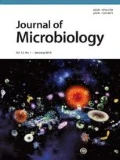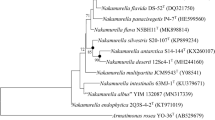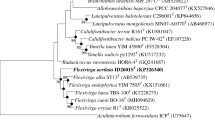Abstract
A Gram-stain-negative and orangish yellow-pigmented bacterial strain, designated PR1014KT, was isolated from an automobile evaporator core collected in Korea. Phylogenetic analysis based on 16S rRNA gene sequences indicated that strain PR1014KT was related with the members of the genus Spirosoma (94.7–90.2%) and closely related with Spirosoma lacussanchae CPCC 100624T (94.7%), Spirosoma knui 15J8-12T (94.3%), and Spirosoma soli MIMBbqt12T (93.3%). The strain grew at 15–40°C (optimum, 25°C), pH 6.5–7.0 (optimum, 6.5) and 0–1% (w/v) NaCl (optimum, 0%). The predominant fatty acids were summed feature 3 (C16:1 ω7c and/or C16:1 ω6c), C16:0, iso-C15:0, C16:1 ω5c, and iso-C17:0 3-OH. The major menaquinone was MK-7. The polar lipid profile of the strain indicated that the presence of one phosphatidylethanolamine, one unidentified aminolipid, two unidentified aminophospholipids, and three unidentified lipids. The DNA G+C content of the strain was 47.4 mol%. On the basis of the phenotypic, genotypic and chemotaxonomic characteristics, strain PR1014KT represents a novel species in the genus Spirosoma, for which the name Spirosoma metallicus sp. nov. (=KACC 17940T =NBRC 110792T) is proposed.
Similar content being viewed by others
References
Ahn, J.H., Weon, H.Y., Kim, S.J., Hong, S.B., Seok, S.J., and Kwon, S.W. 2014. Spirosoma oryzae sp. nov., isolated from rice soil and emended description of the genus Spirosoma. Int. J. Syst. Evol. Microbiol. 64, 3230–3234.
Baik, K.S., Kim, M.S., Park, S.C., Lee, D.W., Lee, S.D., Ka, J.O., Choi, S.K., and Seong, C.N. 2007. Spirosoma rigui sp. nov., isolated from fresh water. Int. J. Syst. Evol. Microbiol. 57, 2870–2873.
Bernardet, J.F., Nakagawa, Y., and Holmes, B. 2002. Proposed minimal standards for describing new taxa of the family Flavobacteriaceae and emended description of the family. Int. J. Syst. Evol. Microbiol. 52, 1049–1070.
Breznak, J.A. and Costilow, R.N. 2007. Physicochemical factors in growth. pp. 309–329. In Beveridge, T.J., Breznak, J.A., Marzluf, G.A., Schmidt, T.M., and Snyder, L.R. (eds.). Methods for general and molecular bacteriology, American Society for Microbiology, Washington, USA.
Chang, X., Jiang, F., Wang, T., Kan, W., Qu, Z., Ren, L., Fang, C., and Peng, F. 2014. Spirosoma arcticum sp. nov., isolated from high Arctic glacial till. Int. J. Syst. Evol. Microbiol. 64, 2233–2237.
Denner, E., Paukner, S., Kämpfer, P., Moore, E., Abraham, W.R., Busse, H.J., Wanner, G., and Lubitz, W. 2001. Sphingomonas pituitosa sp. nov., an exopolysaccharide-producing bacterium that secretes an unusual type of sphingan. Int. J. Syst. Evol. Microbiol. 51, 827–841.
Embley, T.M. and Wait, R. 1994. Structural lipids of eubacteria, pp. 121–161. In Goodfellow, M. and O’Donnell, A.G. (eds.), Modern Microbial Methods. Chemical Methods in Prokaryotic Systematics, John Wiley & Sons, Chichester, England.
Felsenstein, J. 1981. Evolutionary trees from DNA sequences: a maximum likelihood approach. J. Mol. Evol. 17, 368–376.
Felsenstein, J. 1985. Confidence-limits on phylogenies - an approach using the bootstrap. Evolution 39, 783–791.
Finster, K.W., Herbert, R.A., and Lomstein, B.A. 2009. Spirosoma spitsbergense sp. nov. and Spirosoma luteum sp. nov., isolated from a high Arctic permafrost soil, and emended description of the genus Spirosoma. Int. J. Syst. Evol. Microbiol. 59, 839–844.
Fitch, W.M. 1971. Toward defining the course of evolution: minimum change for a specific tree topology. Syst. Zool. 20, 406–416.
Fries, J., Pfeiffer, S., Kuffner, M., and Sessitsch, A. 2013. Spirosoma endophyticum sp. nov., isolated from Zn-and Cd-accumulating Salix caprea. Int. J. Syst. Evol. Microbiol. 63, 4586–4590.
Gonzalez, J. and Saiz-Jimenez, C. 2002. A fluorimetric method for the estimation of G+C mol% content in microorganisms by thermal denaturation temperature. Environ. Microbiol. 4, 770–773.
Kim, D.U. and Ka, J.O. 2014. Roseomonas soli sp. nov., isolated from an agricultural soil cultivated with Chinese cabbage (Brassica campestris). Int. J. Syst. Evol. Microbiol. 64, 1024–1029.
Komagata, K. and Suzuki, K.I. 1987. Lipid and cell-wall analysis in bacterial systematics. Methods Microbiol. 19, 161–207.
Kumar, S., Stecher, G., and Tamura, K. 2016. MEGA7: Molecular evolutionary genetics analysis version 7.0 for bigger datasets. Mol. Biol. Evol. 33, 1870–1874.
Larkin, J.M. and Borral, R. 1984. Family I. Spirosomaceae Larkin and Borrall 1978, 595AL, pp. 125–126. In Krieg, N.R. and Holt, J.G. (eds.). Bergey’s Manual of Systematic Bacteriology, The Williams&Wilkins, Baltimore, USA.
Minnikin, D., O'Donnell, A., Goodfellow, M., Alderson, G., Athalye, M., Schaal, A., and Parlett, J. 1984. An integrated procedure for the extraction of bacterial isoprenoid quinones and polar lipids. J. Microbiol. Methods 2, 233–241.
Pruesse, E., Peplies, J., and Glockner, F.O. 2012. SINA: accurate high-throughput multiple sequence alignment of ribosomal RNA genes. Bioinformatics 28, 1823–1829.
Saitou, N. and Nei, M. 1987. The neighbour-joining method: a new method for reconstructing phylogenetic trees. Mol. Biol. Evol. 4, 406–425.
Sasser, M. 1990. Identification of bacteria by gas chromatography of cellular fatty acids. MIDI technical note 101. MIDI Inc., Newark, DE, USA.
Smibert, R. and Krieg, N. 1994. Phenotypic characterization. pp. 607–654, In Gerhardt, P., Murray, R.G.E., Wood, W.A., and Krieg, N.R. (eds.), Methods for General and Molecular Bacteriology, American Society for Microbiology, Washington, USA.
Ten, L.N., Xu, J.L., Jin, F.X., Im, W.T., Oh, H.M., and Lee, S.T. 2009. Spirosoma panaciterrae sp. nov., isolated from soil. Int. J. Syst. Evol. Microbiol. 59, 331–335.
Yoon, S.H., Ha, S.M., Kwon, S., Lim, J., Kim, Y., Seo, H., and Chun, J. 2017. Introducing EzBioCloud: A taxonomically united database of 16S rRNA and whole genome assemblies. Int. J. Syst. Evol. Microbiol. 67, 1613–161.
Author information
Authors and Affiliations
Corresponding author
Rights and permissions
About this article
Cite this article
Lee, H., Kim, DU., Lee, S. et al. Spirosoma metallicus sp. nov., isolated from an automobile air conditioning system. J Microbiol. 55, 673–677 (2017). https://doi.org/10.1007/s12275-017-7162-4
Received:
Revised:
Accepted:
Published:
Issue Date:
DOI: https://doi.org/10.1007/s12275-017-7162-4




